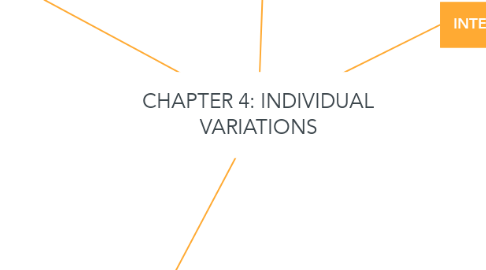
1. Involve a student's tendency either to act quickly and impulsively or to take more time to respond and reflect on the accuracy of the answer.
2. PERSONALITY AND TEMPERAMENT
2.1. Personality
2.1.1. Refers to distinctive thoughts, emotions, and behaviors that characterize the way an individual adapts to the world.
2.1.2. The big 5 personality factors (OCEAN)
2.1.2.1. Openness
2.1.2.1.1. Imaginative or practical.
2.1.2.1.2. Interest in variety or routine.
2.1.2.1.3. Independent or conforming.
2.1.2.2. Conscientiousness
2.1.2.2.1. Organized or disorganized.
2.1.2.2.2. Careful or careless.
2.1.2.2.3. Disciplined or impulsive.
2.1.2.3. Extraversion
2.1.2.3.1. Sociable or retiring.
2.1.2.3.2. Fun-loving or somber.
2.1.2.3.3. Affectionate or reserved.
2.1.2.4. Agreeableness
2.1.2.4.1. Softhearted or ruthless.
2.1.2.4.2. Trusting or suspicious.
2.1.2.4.3. Helpful or uncooperative.
2.1.2.5. Neuroticism (Emotional Stability)
2.1.2.5.1. Calm or anxious.
2.1.2.5.2. Secure or insecure.
2.1.2.5.3. Self-satisfied or self pitying.
2.1.3. Person-situation interaction
2.1.3.1. The best ways to characterize an individual's personality is not in term of traits alone but in terms of both the traits and the situations involved.
2.2. Temperament
2.2.1. Refers to person's behavioral style and characteristic way of responding.
2.2.2. Temperament Classifications proposed by Chess and Stella Thomas.
2.2.2.1. Easy child
2.2.2.1.1. In a positive mood.
2.2.2.2. Difficult child
2.2.2.2.1. Reacts negatively and cries easily.
2.2.2.3. Slow-to-warm-up child
2.2.2.3.1. Low activity level, somewhat negative.
2.2.3. 3 broad dimensions emphasize by Mary Rothbart and John Bates (2006) Kagan proposed inhibition to the unfamiliar.
2.2.3.1. Extraversion/ surgency
2.2.3.1.1. Positive anticipation, impulsivity, activity level and sensation seeking.
2.2.3.2. Negative affectivity
2.2.3.2.1. Consists of fear, frustration, sadness and discomfort.
2.2.3.3. Effortful control (self-regulation)
2.2.3.3.1. involves attentional focusing and shifting, inhibitory control, perceptual sensitivity and low-intensity pleasure.
2.2.3.3.2. Low effortful control link to externalizing problem such as lying while high effortful is opposite of it.
2.2.4. Goodness of fit
2.2.4.1. Is the match between an individual's temperament and the environmental demands the individual must cope.
2.2.4.2. Importance to a child's adjustment.
3. LEARNING AND THINKING STYLES
3.1. Is ways of using abilities.
3.1.1. Impulsive/ Reflective Styles
3.1.1.1. Referred as conceptual tempo.
3.1.2. Deep/ surface styles
3.1.2.1. Involve how students approach learning materials.
3.1.2.1.1. Whether to understand the meaning of materials (deep style) or to learn only what needs to be learned (surface style).
4. INTELLIGENCE
4.1. Intelligence consists of problem-solving skills, ability to adapt to and learn from experiences.
4.2. Intelligence test
4.2.1. Individual intelligence test
4.2.1.1. The Binet tests
4.2.1.1.1. Develop by Alfred Binet and Theophile Simon.
4.2.1.1.2. Binet developed the concept of mental age and Stern created the concept of IQ.
4.2.1.2. The Wechsler scales
4.2.1.2.1. Develop by psychologist David Wechsler.
4.2.1.2.2. Yield an overall IQ plus scores on a number of subscales and composite indexes.
4.2.2. Group intelligence test are more convenient and economical
4.2.2.1. The Lorge-Thorndike intelligence tests.
4.2.2.2. The Otis-Lennon school ability test (OLSAT).
4.3. Theories of multiple intelligences
4.3.1. Sternberg's triarchic theory comes in 3 terms
4.3.1.1. Analytical intelligence
4.3.1.1.1. Ability to analyze, judge, evaluate, compare and contrast.
4.3.1.2. Creative intelligence
4.3.1.2.1. Ability to create, design, invent, originate, and imagine.
4.3.1.3. Practical intelligence
4.3.1.3.1. Ability to use, apply, implement and put to practice.
4.3.2. Gardner's eight frames of mind
4.3.2.1. 1. verbal skills
4.3.2.1.1. Ability to think in words and to use language to express meaning.
4.3.2.2. 2. Mathematical skills
4.3.2.2.1. Ability to carry out mathematical operation.
4.3.2.3. 3. Spatial skills
4.3.2.3.1. Ability to think 3-dimensionally.
4.3.2.4. 4. Bodily-kinesthetic skills
4.3.2.4.1. Ability to manipulate objects and be physically adept.
4.3.2.5. 5. Musical skills
4.3.2.5.1. A sensitivity to pitch, melody, rhythm, and tone.
4.3.2.6. 6. Intrapersonal skills
4.3.2.6.1. Ability to understand oneself and effectively direct one's life.
4.3.2.7. 7. Interpersonal skills
4.3.2.7.1. Ability to understand and effectively interact with others.
4.3.2.8. 8. Naturalist skills
4.3.2.8.1. Ability to observe patterns in nature and understand natural and human-made systems.
4.4. The neuroscience of intelligence
4.4.1. A substantial increase in interest in discovering links between the brain and intelligence has been stimulate by advances in brain imaging.
4.5. Controversies and issues in intelligence
4.5.1. 1. The nature-nurture question of how heredity and environment interact to produce intelligence.
4.5.2. 2. How fairly intelligence testing applies across cultural and ethnic groups.
4.5.3. 3. Whether students should be grouped according to ability (tracking).
